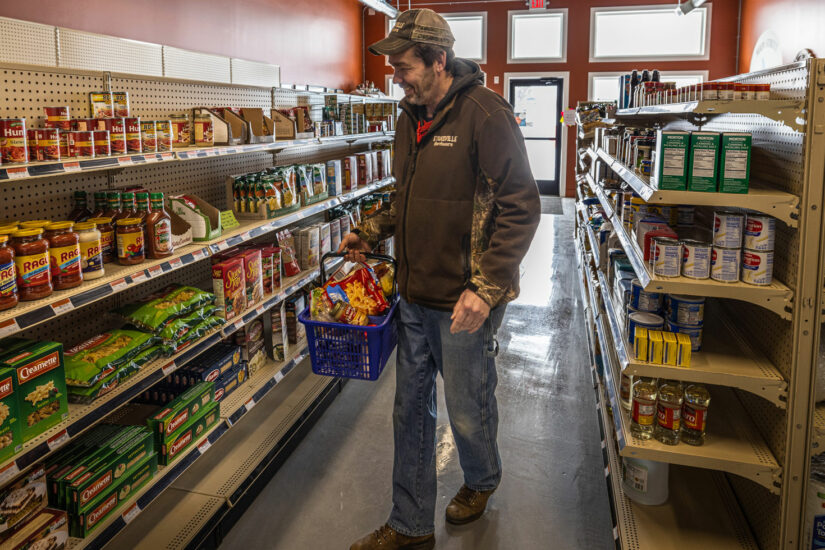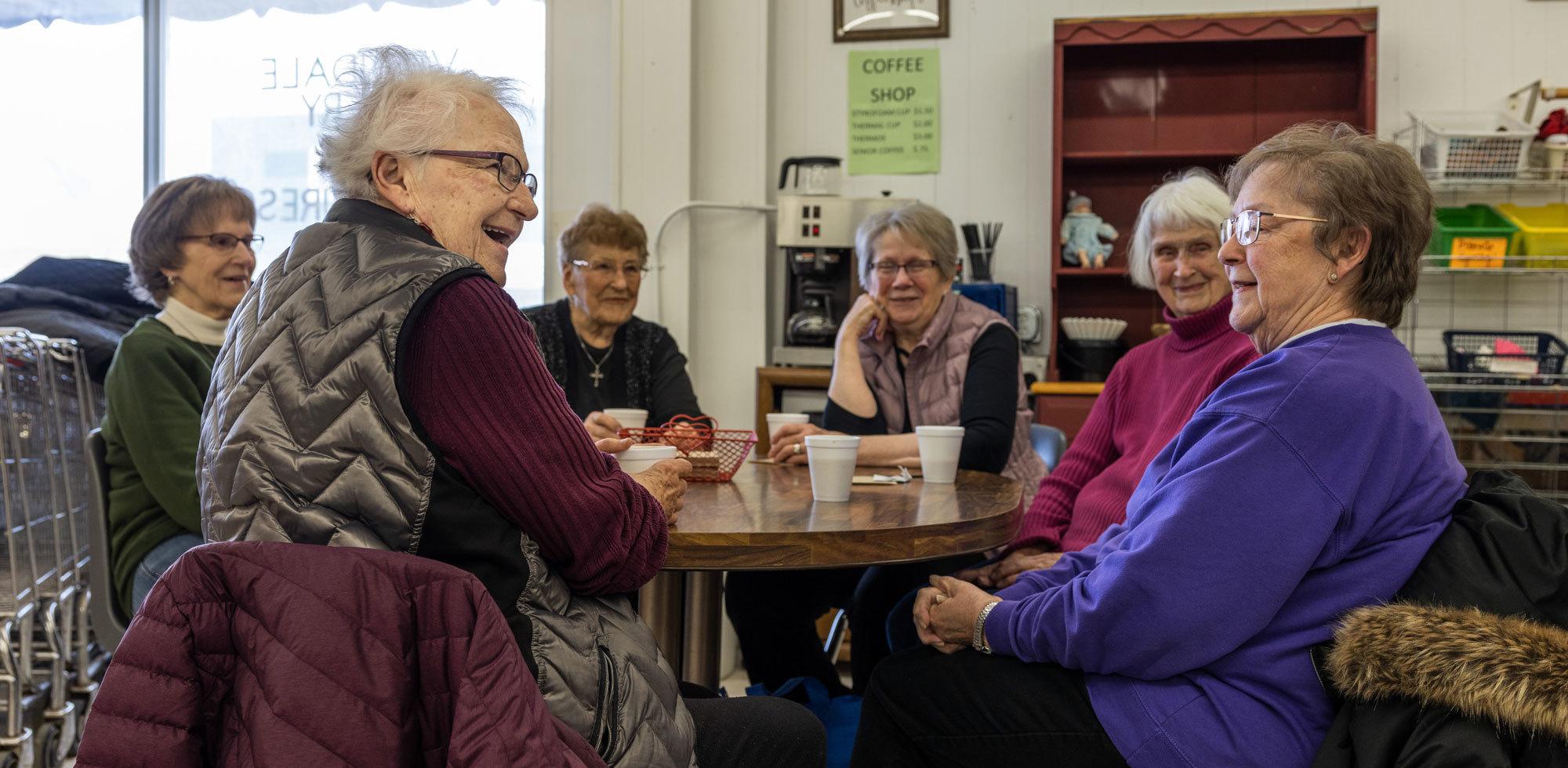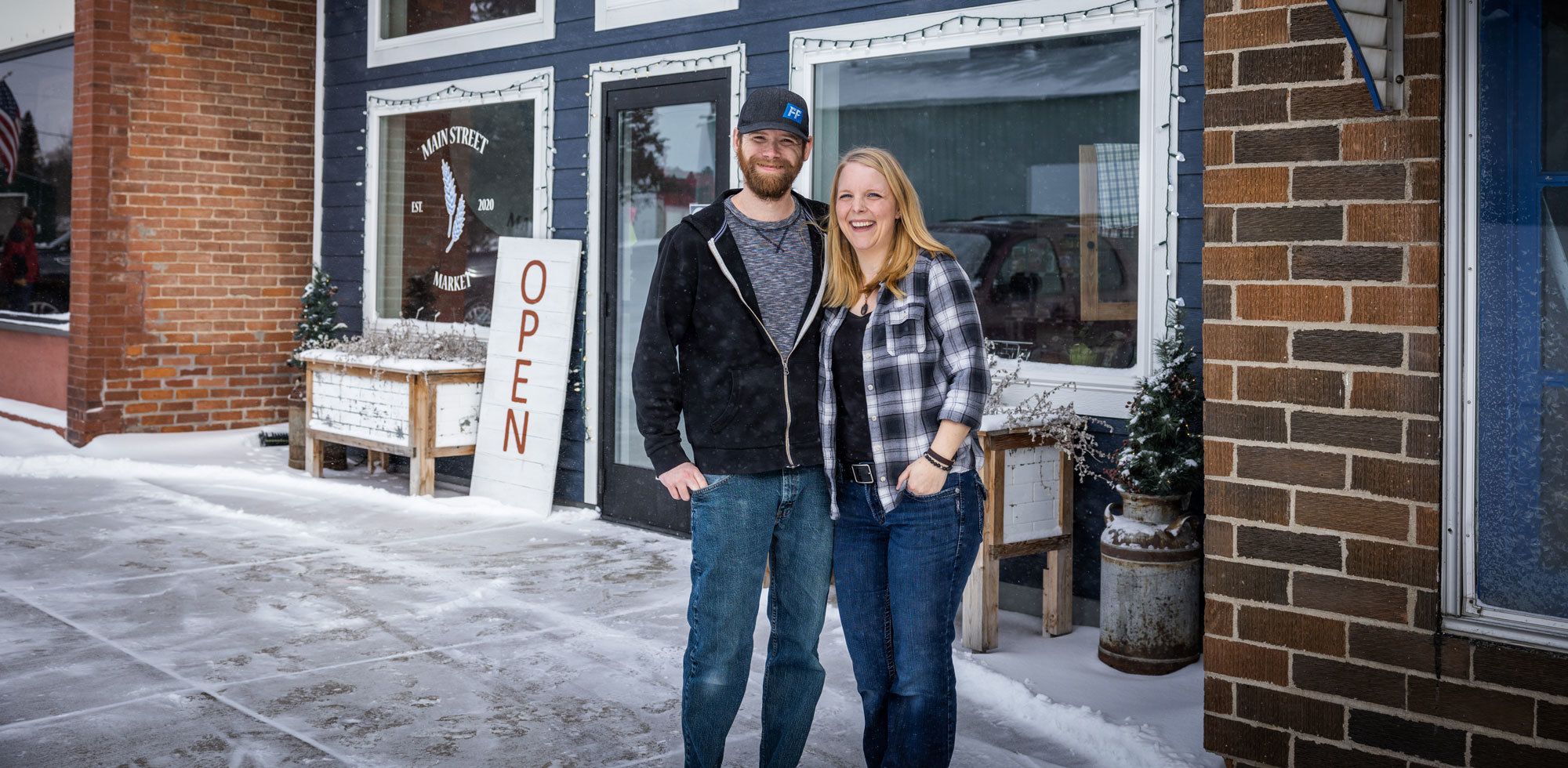
Main Street Mainstays
Rural grocery stores support Central Minnesota’s food needs. They also foster community.
By Elizabeth Foy Larsen | Photography by John Linn
In late 2017, Alex and Caileen Ostenson moved from the Twin Cities to Evansville—a town of 590 residents just 20 minutes from Alexandria—so they could raise their children closer to their extended family. The town’s grocery store, Nelson’s, had recently closed after an almost 70-year run.
Alex Ostenson grew up going to Nelson’s. He remembers buying Twizzlers for a penny, selling seedlings on the sidewalk during springtime, grabbing a gallon of milk after church. The store was a vital part of Evansville’s lifeblood. Now that it was shuttered, Ostenson couldn’t help but notice the impact its absence had on the town.
“It felt like the town was going into hibernation,” he said. “There was this odd sense of quiet.”
A diesel mechanic by trade, Ostenson wasn’t looking for a career change, but Nelson’s closing sparked an idea. As a mechanic, Ostenson often worked odd hours traveling to job sites. He didn’t want to have to drive 20 miles to the nearest supermarket to pick up a box of cereal or a stick of butter at 9 p.m. Could he and Caileen open a new grocery store that would bring life back to Evansville’s Main Street and also be a more convenient solution to the town’s grocery needs?
Missing Ingredients
As grocery stores get bigger, and as ownership grows more concentrated, it’s putting a squeeze on rural areas and creating food deserts in areas of lower population density. In fact, the share of sales from the nation’s top 20 grocery chains more than doubled from 1990 to 2020, according to a January 2023 report from the U.S. Department of Agriculture. That consolidation has been especially difficult for towns too small to support a Walmart, Cub or a Super One Foods. Minnesota has been especially hard hit by this trend: the state has fewer grocery stores per capita than most states and ranks 7th worst in the nation for access to healthy food, according to a 2019 report from the Minnesota Department of Health. Almost 900,000 people in low-income communities across the state—including more than 200,000 children—have insufficient grocery store access.
In towns of 2,500 residents or fewer, privately owned grocery stores often are the community’s anchor business, according to a study conducted by University of Minnesota Extension. In Minnesota, there are 250 rural grocery stores. Ninety-six percent of the 129 stores that participated in the survey agreed that as small businesses, they have a responsibility to their communities.
“For the consumer, having local access to the full range of grocery products—from dairy and meat to produce and toilet paper and diapers—has a high value when it comes food security,” said Kathryn Draeger, Ph.D., the statewide director of the U of M Regional Sustainable Development Partnerships and an author of the Extension survey.
Beyond providing access to what researchers refer to as a “full grocery basket,” Draeger says that rural grocers also are vital to building and maintaining community. They are, she says, examples of the “third place,” which is a social setting that is not a person’s home or workplace. “Grocery stores really help with social cohesion,” she said. “They’re often gathering points, touchstones in our communities.”
On a regional level, small-town grocers are a crucial answer to diversifying supply chain and distribution challenges because they work with providers that are different from the large chain stores. “If a farmer comes to one of these stores and says, ‘I have 500 pounds of potatoes and I’m selling them in 10-pound sacks for $2,’ a rural grocer can negotiate and buy those potatoes on the spot,” she said. “That doesn’t happen at Byerly’s or Cub. … That is a phenomenal asset. I don’t think we’ve thought enough about the critical role that independent rural grocers dotted throughout farm country could play in having a resilient food system for all of our population.” In the Extension survey, more than 25 percent of farmers said they would be willing to serve as a point of redistribution for locally grown food.
Finally, Draeger said that locally owned grocery stores can also be part of a strategy to combat climate change. “I think we have undervalued the climate benefits of having existing assets and maintaining those existing assets,” she said. “Every time we have to start over and build from scratch and recreate, it takes human capacity, it takes more bricks, it takes more cement, it takes more energy, both human and real BTUs, to recreate a system that we already have. We need to start looking at rural groceries and the distribution services that supply them … as assets that we need to maintain and preserve, because to recreate those things is a tremendous energy burden on our system.”

The Basics—and More
An hour northwest of Evansville, the town of Verndale—population 509—relies on Verndale Grocery & Treasure Too, which sells everything from burgers and brats to secondhand clothing and homewares. The store is run by the Wadena County Developmental Achievement Center (DAC), which purchased it in 2011, when the town’s previous grocery store was for sale. They added a thrift store to attract additional customers.
“When the store closed, there was no place where people could grab a gallon of milk,” said Nancy Spencer, DAC’s business manager. Today, the store is an integral part of the town, especially for elderly residents who don’t want to walk across the highway to go to a gas station convenience store.
“People like being able to get a loaf of bread or a bucket of ice cream and not have to travel eight miles to the Walmart or Super One in Wadena,” added Rose Bakke, DAC’s executive director. She said the store also is a gathering spot for residents, a place where a group of women can meet for a cup of coffee or browse the items in the thrift shop and feel connected to the life of the town. “The community would be extremely sad if we closed our doors.”
Keeping those doors open is no small commitment. In 2022, the Initiative Foundation awarded the DAC a $5,000 challenge grant to jumpstart fundraising to repair the store’s roof and make needed upgrades to other DAC buildings.
“I saw this challenge grant as potentially the most important $5,000 investment I was involved with in 2022,” said Zach Tabatt, nonprofit program development officer at the Initiative Foundation.
Federal definitions of what is rural and what is a food desert might skim over the Verndales of the world as underserved communities. But to an elderly, low-income person who lives on the outskirts of town, it can be a tall task to get 8 miles down the road to buy groceries in Wadena. “Supporting the DAC’s grocery presence in Verndale felt like a key investment in the vitality of a small town and a way to serve the invisibly underserved who live in that area.”
What’s more, Tabatt said, the grant helps DAC clients maintain access to dignified work. “In the end, this small investment helps to keep food access local, it helps keep people employed in service to their community, and it supports the DAC’s organizational skills in fundraising by helping staff gain confidence in knowing that their community fully supports the work they do.”

Innovation Unlocks Access
In Evansville, the Ostensons opened Main Street Market in May 2021 with an innovative business model that prizes convenience while also acknowledging that round-the-clock staffing is financially unsustainable. The store is open in the traditional sense of the word—meaning there are cashiers and store workers—on Tuesdays, Thursdays and Saturdays from 9 a.m. to 5 p.m. For people who need more flexibility, Main Street Market sells memberships where people can have round-the-clock access to the store. Memberships are $75 annually. Members can access the store with either a phone app or special key fob and can purchase goods using the app or a self-service checkout. As of January 2023, there were 125 members, including residents of neighboring towns and cabin owners who want to pick up some staples on their way up north.
The store is just 900 square feet, but Ostenson, who is a member of the Initiative Foundation’s 2022-2023 Initiators Fellowship cohort, says they have figured out how to efficiently stock the shelves with the right product mix. “We don’t stock three, four different brands of our products,” he said. “We like to say we’ve got the name brand that everybody recognizes, and then the value brand.”
The Main Street Market model has garnered a lot of media interest, including stories on National Public Radio and a German television news program—rural communities in that country are facing similar challenges and are interested in the Ostensons’ approach.
“Alex’s project has hit a note that elevates the issue of rural food access,” said Christine Metzo, program manager for the Initiators Fellowship, which provides financial and mentoring support for regional social entrepreneurs in the program. (See related story on page 10.) “I think lawmakers should take notice of this and say, ‘Yeah, we’ve got an issue here that has a solution. How do we support others doing the same thing?’”
Halal Meat: A Niche Market
The idea started as a conversation between Doug Virnig, Chad Schirmers and Dan Maurer—three childhood friends, who’d heard about the need for locally-raised halal goat meat for Central Minnesota’s growing Muslim population. Arabic for “lawful and permitted,” the term halal is used for products that are grown, processed and distributed according to specific guidelines that are in accordance with religious principles. In Central Minnesota, there are a handful of farmers who produce fresh halal goat meat, which is a staple in eastern African diets. Those operations are small scale. The rest of the supply comes from New Zealand and Australia. According to the Associated Press, that meat is often six months old by the time it arrives and is difficult to prepare.
Virnig, Schirmers and Maurer all grew up on farms in Pierz. The idea of raising goats appealed to them because it’s a segment of the farming market that isn’t yet well established. While all three partners have established careers, raising halal goats would, they decided, be a rewarding side project that would also answer a growing need in the supply chain. They named their farm True North Livestock and in 2022 bought 25 goats and took over an unused barn on Maurer’s family farm. With support from the Initiative Foundation and Serdar Mamedov at University of Minnesota Extension, they are learning about the halal process and currently are exploring if there are local opportunities to butcher, process and distribute their meat according to halal requirements.
“Our region has long had expertise in meat production,” said Don Hickman, vice president for community and workforce development at the Initiative Foundation. “Stearns County is the top dairy county in the entire state. The opportunity is there. We just need to figure out how all the pieces should align so that we can eventually build this strong and more resilient supply chain.”
If you are interested in connecting with True North Livestock they can be reached at truenorthlivestock@gmail.com.